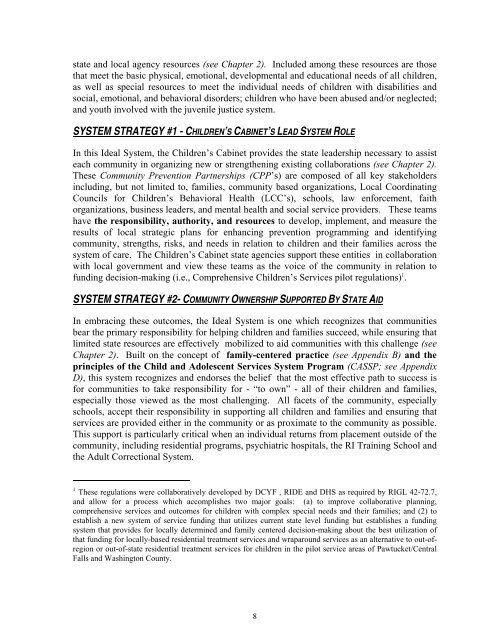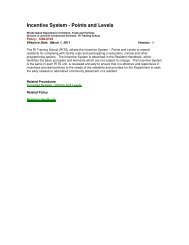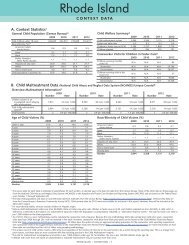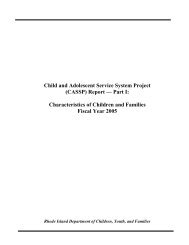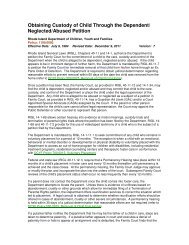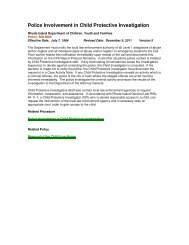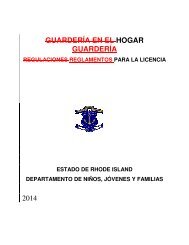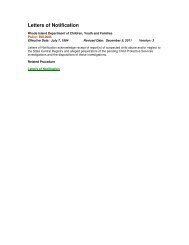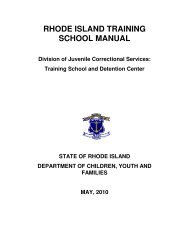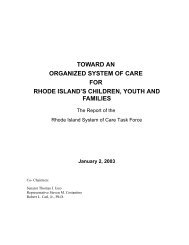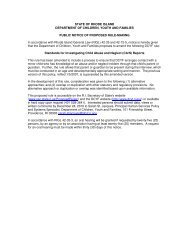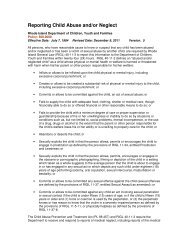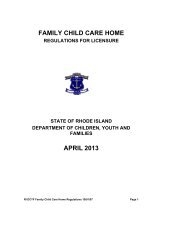system of care for rhode island's children, youth and families
system of care for rhode island's children, youth and families
system of care for rhode island's children, youth and families
You also want an ePaper? Increase the reach of your titles
YUMPU automatically turns print PDFs into web optimized ePapers that Google loves.
state <strong>and</strong> local agency resources (see Chapter 2). Included among these resources are those<br />
that meet the basic physical, emotional, developmental <strong>and</strong> educational needs <strong>of</strong> all <strong>children</strong>,<br />
as well as special resources to meet the individual needs <strong>of</strong> <strong>children</strong> with disabilities <strong>and</strong><br />
social, emotional, <strong>and</strong> behavioral disorders; <strong>children</strong> who have been abused <strong>and</strong>/or neglected;<br />
<strong>and</strong> <strong>youth</strong> involved with the juvenile justice <strong>system</strong>.<br />
SYSTEM STRATEGY #1 - CHILDREN’S CABINET’S LEAD SYSTEM ROLE<br />
In this Ideal System, the Children’s Cabinet provides the state leadership necessary to assist<br />
each community in organizing new or strengthening existing collaborations (see Chapter 2).<br />
These Community Prevention Partnerships (CPP’s) are composed <strong>of</strong> all key stakeholders<br />
including, but not limited to, <strong>families</strong>, community based organizations, Local Coordinating<br />
Councils <strong>for</strong> Children’s Behavioral Health (LCC’s), schools, law en<strong>for</strong>cement, faith<br />
organizations, business leaders, <strong>and</strong> mental health <strong>and</strong> social service providers. These teams<br />
have the responsibility, authority, <strong>and</strong> resources to develop, implement, <strong>and</strong> measure the<br />
results <strong>of</strong> local strategic plans <strong>for</strong> enhancing prevention programming <strong>and</strong> identifying<br />
community, strengths, risks, <strong>and</strong> needs in relation to <strong>children</strong> <strong>and</strong> their <strong>families</strong> across the<br />
<strong>system</strong> <strong>of</strong> <strong>care</strong>. The Children’s Cabinet state agencies support these entities in collaboration<br />
with local government <strong>and</strong> view these teams as the voice <strong>of</strong> the community in relation to<br />
funding decision-making (i.e., Comprehensive Children’s Services pilot regulations) 1 .<br />
SYSTEM STRATEGY #2- COMMUNITY OWNERSHIP SUPPORTED BY STATE AID<br />
In embracing these outcomes, the Ideal System is one which recognizes that communities<br />
bear the primary responsibility <strong>for</strong> helping <strong>children</strong> <strong>and</strong> <strong>families</strong> succeed, while ensuring that<br />
limited state resources are effectively mobilized to aid communities with this challenge (see<br />
Chapter 2). Built on the concept <strong>of</strong> family-centered practice (see Appendix B) <strong>and</strong> the<br />
principles <strong>of</strong> the Child <strong>and</strong> Adolescent Services System Program (CASSP; see Appendix<br />
D), this <strong>system</strong> recognizes <strong>and</strong> endorses the belief that the most effective path to success is<br />
<strong>for</strong> communities to take responsibility <strong>for</strong> - “to own” - all <strong>of</strong> their <strong>children</strong> <strong>and</strong> <strong>families</strong>,<br />
especially those viewed as the most challenging. All facets <strong>of</strong> the community, especially<br />
schools, accept their responsibility in supporting all <strong>children</strong> <strong>and</strong> <strong>families</strong> <strong>and</strong> ensuring that<br />
services are provided either in the community or as proximate to the community as possible.<br />
This support is particularly critical when an individual returns from placement outside <strong>of</strong> the<br />
community, including residential programs, psychiatric hospitals, the RI Training School <strong>and</strong><br />
the Adult Correctional System.<br />
1<br />
These regulations were collaboratively developed by DCYF , RIDE <strong>and</strong> DHS as required by RIGL 42-72.7,<br />
<strong>and</strong> allow <strong>for</strong> a process which accomplishes two major goals: (a) to improve collaborative planning,<br />
comprehensive services <strong>and</strong> outcomes <strong>for</strong> <strong>children</strong> with complex special needs <strong>and</strong> their <strong>families</strong>; <strong>and</strong> (2) to<br />
establish a new <strong>system</strong> <strong>of</strong> service funding that utilizes current state level funding but establishes a funding<br />
<strong>system</strong> that provides <strong>for</strong> locally determined <strong>and</strong> family centered decision-making about the best utilization <strong>of</strong><br />
that funding <strong>for</strong> locally-based residential treatment services <strong>and</strong> wraparound services as an alternative to out-<strong>of</strong>region<br />
or out-<strong>of</strong>-state residential treatment services <strong>for</strong> <strong>children</strong> in the pilot service areas <strong>of</strong> Pawtucket/Central<br />
Falls <strong>and</strong> Washington County.<br />
8


